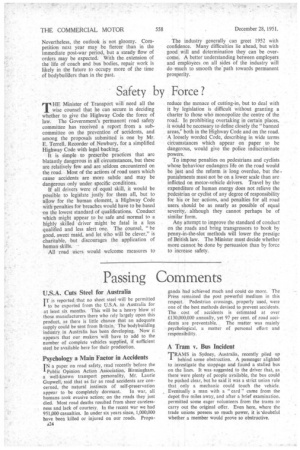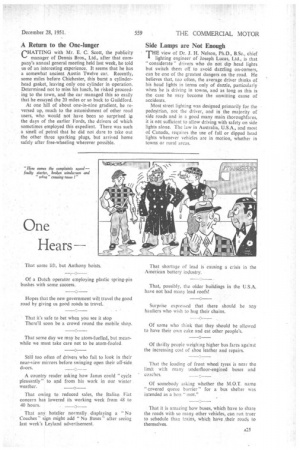Passing Comments
Page 26

Page 27

If you've noticed an error in this article please click here to report it so we can fix it.
U.S.A. Cuts Steel for Australia
IT is reported that no sheet steel will be permitted to be exported from the U.S.A. to Australia for at least six months. This will be a heavy blow at those manufacturers there who rely largely upon this product, as there is little chance that an adequate supply could be sent from Britain. The bodybuilding industry in Australia has been developing. Now it appears that our makers will have to add to the number of complete vehicles supplied, if sufficient steel be available here for their production.
Psychology a Main Factor in Accidents
IN a paper on road safety, read recently before the I Public Opinion Action Association, Birmingham, a well-known transport personality, Mr. Laurie Gupwell, said that as far as road accidents are concerned, the natural instincts of self-preservation
appear to be completely dormant. In war, all humans took evasive action; on the roads they just died. Most road deaths resulted from sheer carelessness and lack of courtesy. In the recent war we had 951,000 casualties. In under six years since, 1,000,000 have been killed or injured on our roads. Propa A24 ganda had achieved much and could do more. The Press remained the post powerful medium in this respect. Pedestrian crossings, properly used, were one of the best methods devised to prevent accidents. The cost of accidents is estimated at over £130,000,000 annually, yet 97 per cent, of road acci dents are preventable. The matter was mainly psychological, a matter of personal effort and responsibility.
A Tram v. Bas Incident
TRAMS in Sydney, Australia, recently piled up behind some obstruction. A passenger alighted to investigate the stoppage and found a stalled bus on the lines. It was suggested to the driver that, as there were plenty of people available, the bus could be pushed clear, but he said it was a strict union rule that only a mechanic could touch the vehicle. Eventually a man with a "card" came from the depot five mites away, and after a brief examination, permitted some eager volunteers from the trams to carry out the original offer. Even here, where the trade unions possess so much power, it is 'doubtful whether a member would prove so obstructive. CHATT1NG with Mr. E. C. Scott, the publicity manager of Dennis 13ros., Ltd., after that company's annual general meeting held last week, he told us of an interesting experience. It seems that he has a somewhat ancient Austin Twelve car. Recently, some miles before Chichester, this burst a cylinderhead gasket, leaving only one cylinder in operation. Determined not to miss his lunch, he risked proceeding to the town, and the car managed this so easily that he essayed the 20 miles or so back to Guildford.
At one hill of about one-in-nine gradient, he reversed up, much to the astonishment of other road users, who would not have been so surprised the days of the earlier Fords, the drivers of which sometimes employed this expedient. There was such a smell of petrol that he did not dare to take out the other three sparking plugs, but arrived home safely after free-wheeling wherever possible.
Side Lamps are Not Enough
THE view of Dr. J. H. Nelson, Ph.D., B.Sc., chief
lighting engineer of Joseph Lucas, Ltd., is that "considerate" drivers who do not dip head lights but switch them off to avoid dazzling on-comers, can be one of the greatest dangers on the road. He believes that, too often, the average driver thinks of his head lights in terms only of dazzle, particularly when he is driving in towns, and as long as this is the case he may become the unwitting cause of accidents.
Most street lighting was designed primarily for the pedestrian, not the driver, and in the majority of side roads and in a good many main thoroughfares, it is net sufficient to allow driving with safety on side lights alone. The law in Australia, U.S.A., and most of Canada, requires the use of full or dipped head lights whenever vehicles are in motion, whether in towns or rural areas.












































































